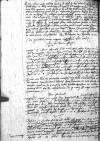Letter #3913
Ioannes [DANTISCUS] to UNKNOWNHeilsberg (Lidzbark Warmiński), 1545-04-09
Manuscript sources:
| ||||
Text & apparatus & commentary Plain text Text & commentary Text & apparatus
Ioannes
Nobilis et erudite fidelis noster dilecte.
Eo quod
Vale et aliquando, ut apud exteros solebas, quodcumque etiam scribe in next line⌈et aliquando, ut apud exteros solebas, quodcumque etiam scribeet aliquando, ut apud exteros solebas, quodcumque etiam scribe in next line⌉.

 AAWO, AB, D. 7, f. 58v
AAWO, AB, D. 7, f. 58v